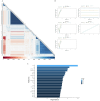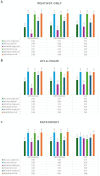Prediction of aflatoxin contamination outbreaks in Texas corn using mechanistic and machine learning models
- PMID: 40109977
- PMCID: PMC11919900
- DOI: 10.3389/fmicb.2025.1528997
Prediction of aflatoxin contamination outbreaks in Texas corn using mechanistic and machine learning models
Abstract
Aflatoxins are carcinogenic and mutagenic mycotoxins that contaminate food and feed. The objective of our research is to predict aflatoxin outbreaks in Texas-grown maize using dynamic geospatial data from remote sensing satellites, soil properties data, and meteorological data by an ensemble of models. We developed three model pipelines: two included mechanistic models that use weekly aflatoxin risk indexes (ARIs) as inputs, and one included a weather-centric model; all three models incorporated soil properties as inputs. For the mechanistic-dependent models, ARIs were weighted based on a maize phenological model that used satellite-acquired normalized difference vegetation index (NDVI) data to predict maize planting dates for each growing season on a county basis. For aflatoxin outbreak predictions, we trained, tested and validated gradient boosting and neural network models using inputs of ARIs or weather, soil properties, and county geodynamic latitude and longitude references. Our findings indicated that between the two ARI-mechanistic models evaluated (AFLA-MAIZE or Ratkowsky), the best performing was the Ratkowsky-ARI neural network (nnet) model, with an accuracy of 73%, sensitivity of 71% and specificity of 74%. Texas has significant geographical variability in ARI and ARI-hotspot responses due to the diversity of agroecological zones (hot-dry, hot-humid, mixed-dry and mixed-humid) that result in a wide variation of maize growth and development. Our Ratkowsky-ARI nnet model identified a positive correlation between aflatoxin outbreaks and prevalence of ARI hot-spots in the hot-humid areas of Texas. In these areas, temperature, precipitation and relative humidity in March and October were positively correlated with high aflatoxin contamination events. We found a positive correlation between aflatoxin outbreaks and soil pH in hot-dry and hot-humid regions and minimum saturated hydraulic conductivity in mixed-dry regions. Conversely, there was a negative relationship between aflatoxin outbreaks and maximum soil organic matter (hot-dry region), and calcium carbonate (hot-dry, and mixed-dry). It is likely soil fungal communities are more diverse, and plants are healthier in soils with high organic matter content, thereby reducing the risk of aflatoxin outbreaks. Our results demonstrate that intricate relationships between soil hydrological parameters, fungal communities and plant health should be carefully considered by Texas corn growers for aflatoxin mitigation strategies.
Keywords: Aspergillus; aflatoxin; corn; gradient boosting; machine learning; neural network; soil.
Copyright © 2025 Castano-Duque, Avila, Mack, Winzeler, Blackstock, Lebar, Moore, Owens, Mehl, Su, Lindsay and Rajasekaran.
Conflict of interest statement
The authors declare that the research was conducted in the absence of any commercial or financial relationships that could be construed as a potential conflict of interest.
Figures








Similar articles
-
Dynamic geospatial modeling of mycotoxin contamination of corn in Illinois: unveiling critical factors and predictive insights with machine learning.Front Microbiol. 2023 Nov 1;14:1283127. doi: 10.3389/fmicb.2023.1283127. eCollection 2023. Front Microbiol. 2023. PMID: 38029202 Free PMC article.
-
Gradient boosting machine learning model to predict aflatoxins in Iowa corn.Front Microbiol. 2023 Sep 1;14:1248772. doi: 10.3389/fmicb.2023.1248772. eCollection 2023. Front Microbiol. 2023. PMID: 37720139 Free PMC article.
-
Gradient boosting and bayesian network machine learning models predict aflatoxin and fumonisin contamination of maize in Illinois - First USA case study.Front Microbiol. 2022 Nov 10;13:1039947. doi: 10.3389/fmicb.2022.1039947. eCollection 2022. Front Microbiol. 2022. PMID: 36439814 Free PMC article.
-
Influences of climate on aflatoxin producing fungi and aflatoxin contamination.Int J Food Microbiol. 2007 Oct 20;119(1-2):109-15. doi: 10.1016/j.ijfoodmicro.2007.07.060. Epub 2007 Aug 14. Int J Food Microbiol. 2007. PMID: 17881074 Review.
-
Pre- and post-harvest aflatoxin contamination and management strategies of Aspergillus spoilage in East African Community maize: review of etiology and climatic susceptibility.Mycotoxin Res. 2024 Nov;40(4):495-517. doi: 10.1007/s12550-024-00555-0. Epub 2024 Sep 12. Mycotoxin Res. 2024. PMID: 39264500 Review.
Cited by
-
The use of artificial intelligence to improve mycotoxin management: a review.Mycotoxin Res. 2025 Aug 8. doi: 10.1007/s12550-025-00602-4. Online ahead of print. Mycotoxin Res. 2025. PMID: 40779098 Review.
References
-
- Abdelfatah K., Senn J., Glaeser N., Terejanu G. (2019). Prediction and measurement update of fungal toxin geospatial uncertainty using a stacked Gaussian process. Agric. Syst. 176:102662. doi: 10.1016/j.agsy.2019.102662 - DOI
-
- Abdel-Hadi A., Schmidt-Heydt M., Parra R., Geisen R., Magan N. (2012). A systems approach to model the relationship between aflatoxin gene cluster expression, environmental factors, growth and toxin production by aspergillus flavus. J. R. Soc. Interface 9, 757–767. doi: 10.1098/rsif.2011.0482 - DOI - PMC - PubMed
-
- Battilani P., Camardo Leggieri M., Rossi V., Giorni P. (2013). AFLA-maize, a mechanistic model for aspergillus flavus infection and aflatoxin B1 contamination in maize. Comput. Electron. Agric. 94, 38–46. doi: 10.1016/j.compag.2013.03.005 - DOI
LinkOut - more resources
Full Text Sources

